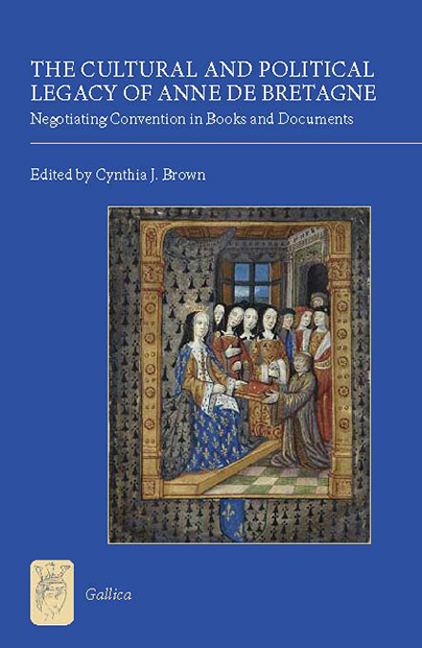Book contents
- Frontmatter
- Contents
- List of Illustrations
- List of Contributors
- List of Abbreviations
- Introduction
- Part I The Politics of Bookmaking in Fifteenth- and Sixteenth-Century Brittany: Cooperation and Competition between France and the Queen's Duchy
- Part II The Politics of Literary and Religious Traditions: How Books (Re)Defined the Queen
- Part III Anne's Cultural and Political Legacy to Claude: Harmonies and Tensions in Two Queenships
- Part IV The Cultural and Political Legacies of Negotiations and Rituals: Contesting Convention
- Appendix The Children of Anne de Bretagne
- Bibliography
- Index
- Miscellaneous Endmatter
Introduction
Published online by Cambridge University Press: 28 April 2017
- Frontmatter
- Contents
- List of Illustrations
- List of Contributors
- List of Abbreviations
- Introduction
- Part I The Politics of Bookmaking in Fifteenth- and Sixteenth-Century Brittany: Cooperation and Competition between France and the Queen's Duchy
- Part II The Politics of Literary and Religious Traditions: How Books (Re)Defined the Queen
- Part III Anne's Cultural and Political Legacy to Claude: Harmonies and Tensions in Two Queenships
- Part IV The Cultural and Political Legacies of Negotiations and Rituals: Contesting Convention
- Appendix The Children of Anne de Bretagne
- Bibliography
- Index
- Miscellaneous Endmatter
Summary
This interdisciplinary volume of articles concentrates on the cultural and political legacy of Anne de Bretagne (1477–1514). As duchess of Brittany (1491–1514) and twice queen of France (1491–98; 1499–1514) during a period when major political, religious and cultural transitions were the order of the day, Anne set a benchmark by which to measure the status of female authority in Europe at the dawn of the Renaissance. Twice a ‘foreign’ bride with no surviving male children, she outlived one husband and briefly benefited from the independence that widowhood afforded women of her era. Although she was at times a traditional political pawn when the men who ruled her life were involved in reshaping European alliances, Anne de Bretagne gained prominence as an autonomous female ruler of Brittany, both before her marriage to Charles VIII in 1491 and during her second marriage to Louis XII (1499–1514). As duchess of Brittany, she played a critical role in the negotiation of her own marriages. As French queen, however, she struggled to wield political power in the negotiation of the marriage of her daughter, Claude de France, to a non-French spouse in order to maintain the independence of Brittany. In addition, Anne's legal challenge of the Maréchal de Gié's supposed act of lèse-majesty resulted in a rather subdued political victory. Although Anne gave birth to ten infants in a valiant attempt to produce an heir to the throne, only two children survived, Claude and Renée. Despite such setbacks, Anne was directly or indirectly involved with the principal political and religious European leaders of the late fifteenth and early sixteenth centuries and, as a major patroness of the arts, she helped define the cultural landscape of her era.
Anne de Bretagne's privileged position in late-medieval and early-Renaissance Europe has prompted a recent flurry of works about the queen-duchess that attests to the ever-increasing recognition of her cultural and political importance. Among the most significant of the latest publications is the 2007 catalogue of the exhibition on Anne de Bretagne that took place at the Château des ducs de Bretagne – Musée d'histoire de Nantes, entitled Anne de Bretagne: une histoire, un mythe.
- Type
- Chapter
- Information
- The Cultural and Political Legacy of Anne de BretagneNegotiating Convention in Books and Documents, pp. 1 - 8Publisher: Boydell & BrewerPrint publication year: 2010

